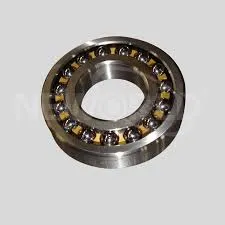
dec . 23, 2024 06:16 Back to list
Design and Applications of Angular Contact Ball Bearings in Precision Machinery
Understanding Angular Contact Ball Bearings
Angular contact ball bearings are specialized types of rolling element bearings designed to handle both radial and axial loads simultaneously. Unlike standard deep groove ball bearings, which predominantly support radial loads, angular contact ball bearings excel in applications where load direction may vary or where combined loading conditions are prevalent. This unique functionality makes them indispensable in various industrial settings.
Design and Structure
The fundamental design of angular contact ball bearings includes an inner and an outer raceway with a specific angle of contact that distinguishes them from other bearing types. This angle, which can vary from 15 to 40 degrees, allows the bearing to accommodate axial loads in one direction efficiently while still handling radial loads. The angle of contact is essential for the performance of the bearing, as it helps in distributing the load evenly across the rolling elements, thus minimizing wear and tear.
The rolling elements in angular contact ball bearings are typically made of high-quality steel to ensure durability and longevity. They are arranged in a way that optimizes load distribution, typically in a single row for simpler applications or in multiple rows for more complex machinery requiring higher load capacities.
Applications
Angular contact ball bearings find extensive use in a variety of applications due to their unique capabilities. Common applications include electric motors, automotive components, machine tools, and aerospace systems. In electric motors, for example, they are crucial for supporting the rotor and shaft, allowing for quieter operation and increased efficiency.
Additionally, in high-speed applications such as machine tools, angular contact ball bearings play a vital role. They can operate at elevated speeds while maintaining precision and stability, making them ideal for spindle applications where both speed and load handling are critical.
angular contact ball bearing

Load Handling
One of the standout features of angular contact bearings is their ability to accommodate axial loads in one direction. When two bearings are used in tandem, they can support axial loads in both directions. This is particularly effective in applications such as gearboxes where both radial and axial forces are prevalent. By adjusting the preload — the contact force between the rolling elements and raceways — engineers can further enhance the performance and lifespan of these bearings.
Preloading can significantly decrease the bearing's sensitivity to vibrations and changes in operational conditions, which is critical in precision applications. However, careful consideration must be given, as excessive preload can lead to increased friction and heat generation, potentially resulting in premature failure.
Benefits
The use of angular contact ball bearings provides numerous advantages. First, their ability to handle combined loads effectively means that machinery can be designed to be more compact and efficient. Additionally, they tend to have lower friction compared to other bearing types, leading to improved energy savings and reduced operational costs.
Moreover, these bearings generally offer higher speeds and better performance in demanding environments, which is essential for high-tech industrial applications where precision is paramount. Their robust design and construction also translate to enhanced durability, which can lower maintenance costs over time.
Conclusion
In summary, angular contact ball bearings are crucial components in modern machinery, providing an efficient solution for handling both radial and axial loads. Their unique design, combined with their ability to operate under various conditions, makes them a preferred choice in numerous industrial applications. As technology continues to evolve, the role of angular contact ball bearings will likely expand, emphasizing the importance of proper bearing selection and maintenance to ensure optimal performance and reliability in engineering applications.
Latest news
-
Premium Deep Groove Ball Bearings | High Speed & Reliability
NewsAug.29,2025
-
Durable Scaffolding Clamps - Secure & Reliable Tube Connectors
NewsAug.28,2025
-
Common Failures in Thrust Ball Bearings and Solutions
NewsAug.22,2025
-
How Tapered Roller Bearings Can Take Shock Loads
NewsAug.22,2025
-
Angular Bearings in High-Precision Spindles
NewsAug.22,2025
-
The Impact of Misalignment on Cylindrical Roller Bearing Performance
NewsAug.22,2025
